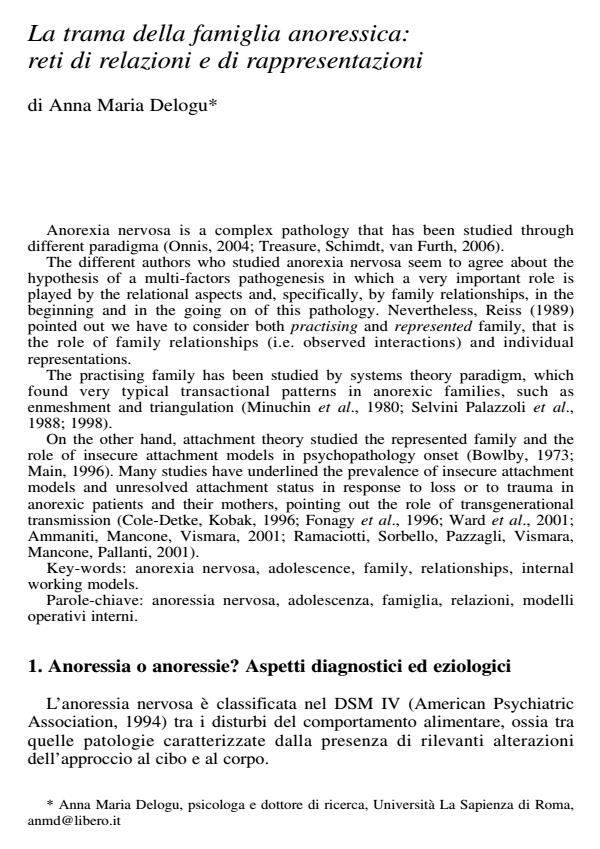La trama della famiglia anoressica: reti di relazioni e di rappresentazioni
Journal title SALUTE E SOCIETÀ
Author/s Anna Maria Delogu
Publishing Year 2009 Issue 2009/3
Language Italian Pages 18 P. 94-111 File size 156 KB
DOI 10.3280/SES2009-003006
DOI is like a bar code for intellectual property: to have more infomation
click here
Below, you can see the article first page
If you want to buy this article in PDF format, you can do it, following the instructions to buy download credits

FrancoAngeli is member of Publishers International Linking Association, Inc (PILA), a not-for-profit association which run the CrossRef service enabling links to and from online scholarly content.
La trama della famiglia anoressica: reti di relazioni e di rappresentazioni - Anorexia nervosa is a complex pathology that has been studied through different paradigma (Onnis, 2004; Treasure, Schimdt, van Furth, 2006). The different authors who studied anorexia nervosa seem to agree about the hypothesis of a multi-factors pathogenesis in which a very important role is played by the relational aspects and, specifically, by family relationships, in the beginning and in the going on of this pathology. Nevertheless, Reiss (1989) pointed out we have to consider both practising and represented family, that is the role of family relationships (i.e. observed interactions) and individual representations. The practising family has been studied by systems theory paradigm, which found very typical transactional patterns in anorexic families, such as enmeshment and triangulation (Minuchin et al., 1980; Selvini Palazzoli et al., 1988; 1998). On the other hand, attachment theory studied the represented family and the role of insecure attachment models in psychopathology onset (Bowlby, 1973; Main, 1996). Many studies have underlined the prevalence of insecure attachment models and unresolved attachment status in response to loss or to trauma in anorexic patients and their mothers, pointing out the role of transgenerational transmission (Cole-Detke, Kobak, 1996; Fonagy et al., 1996; Ward et al., 2001; Ammaniti, Mancone, Vismara, 2001; Ramaciotti, Sorbello, Pazzagli, Vismara, Mancone, Pallanti, 2001).
Key-words: anorexia nervosa, adolescence, family, relationships, internal working models.
Parole-chiave: anoressia nervosa, adolescenza, famiglia, relazioni, modelli operativi interni.
Anna Maria Delogu, La trama della famiglia anoressica: reti di relazioni e di rappresentazioni in "SALUTE E SOCIETÀ" 3/2009, pp 94-111, DOI: 10.3280/SES2009-003006